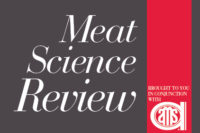The increasingly lengthier distance and time between slaughtering and consumption has created a demand for a variety of ways to safeguard meat and extend shelf life. Particular shelf-life extending ingredient groups have benefited from these demands.
Salt, an ancient method of preserving meat, continues to be the most popular method of extending shelf life, says Kantha Shelke, food scientist and principal of Chicago-based Corvus Blue LLC, a food science and research firm. “Salt absorbs excess moisture from the meat and poultry products and renders them unsuitable to microbes, prevents spoilage and thereby extends their shelf life,” she explains. “Meat and poultry processors are reaching out for black salt, pink salt and smoked salts as replacement for plain salts and are appealing to those who want taste and variety. Because people are avoiding salt across the board, some processors are replacing some of the salt with sugar to affect net reduction in water activity and the resulting preservative effect.”
A growing area of shelf-life extending ingredients is those naturally derived from plants.
“Synthetic preservatives, such as nitrites and benzoates, are added to meats to reduce pH, reduce moisture level and hinder the rate of ripening and thereby act as antimicrobials and enhance shelf life,” Shelke explains. “Consumer avoidance of preservatives is not safe for meats. Processors, instead of removing synthetic nitrites, are replacing them with naturally occurring nitrites formed by treating nitrate-rich celery juice with bacterial culture and labeling the finished products as ‘uncured’ or ‘no nitrite added.’”
Jeff Sindelar, an associate professor in the Department of Animal Science at the University of Wisconsin-Madison, agrees that more processors are looking at clean-label types of shelf-life extension approaches. For example, more processors are interested in shelf-life extension methods that don’t need to be included on the ingredient deck, or if the shelf-life extending ingredient does, that it’s recognizable by consumers, he says.
In addition to ingredients, advancements in packaging are aiding processors in shelf-life extension. “While the primary purpose of packaging is to protect meats and poultry from contamination by dirt and micro-organisms, it is also advancing to use science and modeling to optimize and even extend the shelf life of these foodstuffs,” Shelke says.
For example, technologies such as high-pressure processing help provide another hurdle for pathogens and spoilage microbes in products with clean-label ingredients. “Expect to see more of it,” Shelke says.
Challenges
Some of the challenges of using shelf-life extenders for processors are validation and regulatory approval of these ingredients. “Meat and poultry products are governed by the USDA and require a sign-off from USDA before they can launch the product,” Shelke says. “This is both good news and bad news. Good that meat food products have to be tested and approved by the USDA before they enter the marketplace and bad because of the hoops that new ingredients and technologies have to jump through to be allowed into the marketplace and often have to meet archaic criteria of safety that were established for a different ingredient or technology.”
In addition, the plant-based, clean-label ingredients for meat and poultry shelf-life extension are not standardized for composition and potency and therefore overused to compensate for shortcomings. The reformulated products also have to be tested and proven, and this requires additional investment for challenge testing. Another challenge with using these plant-based ingredients is the lack of consistency, which is bound to get worse before it gets better, Shelke says.
Shelf-life extension is also tricky because there’s microbial shelf-life extension, which is trying to control bacteria, in addition to chemical or qualitative shelf-life extension, which is when processors are trying to maintain color or control the state of the fat. Processors can prevent or slow oxidation of fats as well as oxidation of proteins, depending on the type of product being made. For example, if processors are making a fresh product, generally shelf extenders are focused on maintaining color, Sindelar explains. If it is a cooked product, then processors are focused on controlling oxidation of fats as well as some prevention of exposed bacteria. If the product is cured, processors are primarily focused on controlling growth of spoilage bacteria.
In turn, the biggest challenge is that shelf life is not controlled by a single factor. “There are multiple factors that impact it, so the use of an ingredient that has shelf-life extension capabilities, although they are effective, can also provide a false sense of security,” Sindelar says. “If there is another factor that eliminates the function of that shelf-life extender, then it’s all for naught. If there’s anything like temperature abuse or quality issues with raw materials or high levels of spoilage bacterial in the raw materials, it can render the shelf-life extenders to be inactive. When products are manufactured, the expected shelf life is such, and by using a shelf-life extender with one of these other conditions it can actually result in shorter shelf life than what would be expected because the shelf-life extender was used.”
Overcoming these challenges requires processors to understand what factors affect shelf life, to design quality control programs to ensure those factors are controlled, and then to allow the ingredients that are added to a system, such as a shelf extender, to be able to do their job as effectively as possible by understanding and controlling variables of other factors, Sindelar says.
In addition, most natural shelf-life extenders are more challenging to formulate with than their synthetic counterparts.
“Shelf-life extension is not an easy thing to be successful at, so using ingredients that aren’t exactly designed for shelf-life extension but have attributes to contribute to it are always harder to work with and harder to show desired results than those that are designed for that specific function,” Sindelar says. “Those unfortunately usually fall in the classification of synthetic or manufactured ingredients, but there’s a reason that those ingredients exist because they are designed for a specific function, which otherwise is not generally available.”
Future of shelf-life extenders
Moving forward, certain trends are expected to affect shelf-life extending ingredients in meat and poultry. The first is mindfulness, which is trumping practically every other trend today.
“People are becoming mindful of what they choose and how what they choose was made,” Shelke says. “Mindfulness has raised consumer concern about naturalness and minimal processing techniques. Formulators, therefore, demand clean-label ingredients derived without extensive manipulation or modification from wholesome foods, such as celery, yogurt and cherries instead of synthetic ingredients.”
Another notable trend in the marketplace is the use of new ingredients while also using trusted old ingredients in new and globally inspired recipes.
“Clean-label ingredients are helping transform old staples such as hams, hot dogs, chicken sausage and bacon enter a new category with plant-based solutions or alternatives to synthetic ingredients and are transforming meat products from the ordinary to the extraordinary with new textures and tastes,” Shelke says.
Transparency is another important element in flavor trends and the addition of simple, food-based, clean-label ingredients is considered far more clean-label, transparent and trustable than the use of synthetic ingredients and preservatives, she says. In addition, the growing awareness of the effect of food choices on health is driving the preferential demand for plant-based options for practically every aspect including the preservation and shelf-life extension of animal-based favorites.
Clean-label also has rapidly evolved as the de facto standard in mainstream foods. “The concept of ‘clean,’ however, varies with the region, category of food and the target audience, but the basic premise is the same,” Shelke says. “In general, the clean-label trend shuns selective food additives like synthetic colors, preservatives, stabilizers, emulsifiers and texturizers and embraces natural wholesome ingredients that have served people well with a long history of use.”
Sindelar also doesn’t see an increase in the use of synthetic shelf-life extension ingredients, but an increase of those that come from more natural sources. He sees a trend of creating shelf-life extension systems that would use multiple ingredients that are more powerful together than independently.
Sindelar thinks processors will continue to incorporate ingredients into a total system and include quality raw materials and cold chain management. He thinks ingredients will cater to the product and the process. NP






Report Abusive Comment